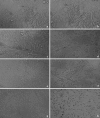Characterization of cytopathogenicity of classical swine fever virus isolate induced by Newcastle disease virus
- PMID: 26436124
- PMCID: PMC4585056
- DOI: 10.1007/s13337-015-0253-0
Characterization of cytopathogenicity of classical swine fever virus isolate induced by Newcastle disease virus
Abstract
Classical swine fever virus (CSFV), the causative agent of classical swine fever, belongs to the family Flaviviridae and genus Pestivirus. Some pestiviruses exhibit cytopathic effect in cell culture but exact phenomenon is unknown. Over expression of NS2-3 gene, presence of defective interfering particle and exaltation of Newcastle disease virus (END) phenomenon could be the reasons of cytopathogenicity. In the present study, a CSFV isolate exhibiting cytopathic effect (CPE) in Madin-Darby Canine Kidney (MDCK) cell line was characterized. To characterize cytopathogenicity of such isolate, END test was carried out. Interference of Newcastle disease virus (NDV) in MDCK adapted CSFV was confirmed by RT-PCR and virus neutralization test. Absence of CPE and NDV specific nucleic acid after neutralization confirmed the induction of CPE by NDV. Further, identity of the CSFV isolate in MDCK cell line by immunoperoxidase test, immunoblotting and RT-PCR post NDV neutralization established the virus replication without CPE (non-cytopathic isolate). Findings suggest that, there could be a chance of mixed infection of both CSFV and NDV in the piglet from which the sample was collected for virus isolation.
Keywords: CSF; Cytopathogenicity; END phenomenon; MDCK; VNT; Virus.
Figures






Similar articles
-
Characterization of classical swine fever virus associated with defective interfering particles containing a cytopathogenic subgenomic RNA isolated from wild boar.J Vet Med Sci. 2001 Jul;63(7):751-8. doi: 10.1292/jvms.63.751. J Vet Med Sci. 2001. PMID: 11503902
-
Cytopathogenicity of classical swine fever viruses that do not show the exaltation of Newcastle disease virus is associated with accumulation of NS3 in serum-free cultured cell lines.J Vet Med Sci. 2004 Feb;66(2):161-7. doi: 10.1292/jvms.66.161. J Vet Med Sci. 2004. PMID: 15031544
-
Porcine cells persistently infected with classical swine fever virus protected from pestivirus-induced cytopathic effect.J Gen Virol. 1998 Dec;79 ( Pt 12):2981-7. doi: 10.1099/0022-1317-79-12-2981. J Gen Virol. 1998. PMID: 9880012
-
Genetic variability and distribution of Classical swine fever virus.Anim Health Res Rev. 2015 Jun;16(1):33-9. doi: 10.1017/S1466252315000109. Anim Health Res Rev. 2015. PMID: 26050570 Review.
-
Laboratory diagnosis, epizootiology, and efficacy of marker vaccines in classical swine fever: a review.Vet Q. 2000 Oct;22(4):182-8. doi: 10.1080/01652176.2000.9695054. Vet Q. 2000. PMID: 11087126 Review.
References
-
- Aoki H, Ishikawa K, Sakoda Y, Sekiguchi H, Kodama M, Suzuki S, Fukusho A. Characterization of classical swine fever virus associated with defective interfering particles containing a cytopathogenic subgenomic RNA isolated from wild boar. J Vet Med Sci. 2001;63:751–758. doi: 10.1292/jvms.63.751. - DOI - PubMed
-
- Cheng LF, Ke MF, Zheng T, Huang Y, Li WY, Shi SH. Isolation and identification of Newcastle disease virus from swine. Chin J Vet Sci Tech. 2004–12. http://en.cnki.com.cn/Article_en/CJFDTOTAL-ZGSY200412020.htm.
LinkOut - more resources
Full Text Sources
Other Literature Sources
Research Materials
Miscellaneous

